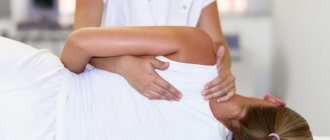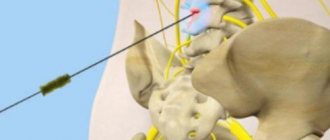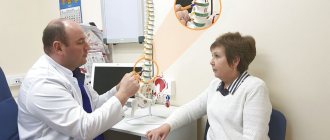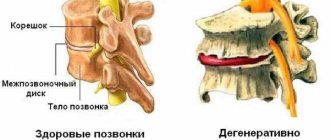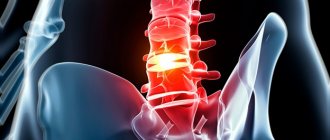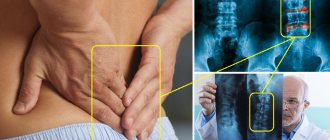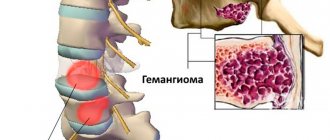Author
: Grachev Ilya Illarionovich
Editor
: Efremov Mikhail Mikhailovich
Date of publication: 05.13.2014 Date of update: 12.11.2020
There is no universal definition for such a phenomenon as dorsalgia. This term refers to any back pain of nonspecific origin, regardless of the nature and accompanying symptoms. The disease involves benign changes.
Like any ailment associated with the spine, dorsalgia can appear at almost any age. People who have jobs that involve constant physical activity or athletes may be especially susceptible to this phenomenon. The disease can also occur as a result of a back injury.
Any type of dorsalgia has serious complications, so you should not delay treatment.
See how easy it is to cure a disease in 10 sessions
Causes of dorsalgia
All currently known causes of dorsalgia are quite numerous. They can be associated both with direct problems with the spine and signal the presence of other ailments, for example, internal organs. The main factors for the occurrence of the disease are:
- Staying in an uncomfortable position for a long time,
- Muscle strain, physical overload,
- Depression, severe stress,
- Injuries, diseases of internal organs,
- Pathological changes in the spine (with vertebrogenic form),
- Hypothermia and drafts can also cause dorsalgia.
Dorsalgia of the cervical region
With cervical dorsalgia, compression of the roots, compression of blood vessels, compression of the spinal cord may occur, and may be accompanied by mixed paresis of the arms. The patient complains of pain in the neck, upper shoulder, posterior surface of the shoulder, scapula, and hypotension of the shoulder muscles. The pain can be shooting or chronic. Cervical dorsalgia does not cause sensory impairment. The causes of this type of dorsalgia can be various factors, among them: osteochondrosis, microtrauma of joints and tendons.
Types of dorsalgia
At the moment, it is customary to distinguish 2 classic types of the disease, based on the reason for its development:
|
Characteristics of dorsalgia and its types
Depending on the cause of its occurrence, dorsalgia is divided into:
- vertebrogenic - occurs due to pathological changes in the components of the spine, which are accompanied by an inflammatory process, are a consequence of trauma to the spinal column, or are neoplastic in nature (malignant tumors);
- nonvertebrogenic – occurs against the background of muscle strains, prolonged stress and other psychogenic factors, as a result of muscle spasms and prolonged tension in the back muscles.
Depending on the causes of dorsalgia, the pain syndrome can be vertebrogenic and non-vertebrogenic
Based on the location of painful sensations, the following types of pain syndrome are determined::
- cervicalgia – pain in the cervical spine;
- Thoracalgia – pain in the thoracic spine;
- lumbodynia - pain in the lumbar spine.
Dorsalgia can be combined and simultaneously affect two or three parts of the spine.
Symptoms of dorsalgia
All existing symptoms of dorsalgia are associated with painful sensations in the back, which last for 2-3 weeks and may periodically intensify. Classic symptoms in this case include:
- Feeling of painful discomfort in the spine area.
- Mild pain that worsens during movement or with deep breathing, coughing, sneezing.
- Often, a painful sensation appears after a sudden movement or after physical activity, and then suddenly goes away.
What is POSSIBLE for diseases of the spine
What NOT to do for spinal diseases
Treatment
Bed rest is necessary only for acute radiating pain (for example, sciatica) and should not last more than 1-3 days, as this avoids the progression of a decrease in physical activity and the appearance of pathological behavioral dominants. With all nonspecific myofascial pain, lack of physical activity will have a devastating physiological effect, leading to muscle and other soft tissue wasting, joint hypomobility, decreased muscle strength, and bone demineralization. Therefore, bed rest is generally not recommended. Patients are advised to maintain normal physical activity as much as possible. Bed rest leads to the patient developing a fear of movement and the formation of a pathological behavioral cycle.
Drug treatment is often prescribed for dorsalgia and, moreover, long-term unreasonable prescription of NSAIDs is carried out, which not only do not have a pathogenetic effect, but also cause a lot of side effects. The use of NSAIDs is justified for acute pain and for a short period of time. For dorsalgia (nonspecific pain), central muscle relaxants are also prescribed to relieve muscle spasm. If we are talking about chronic pain syndrome, the prescription of antidepressants is justified, since in chronic pain syndrome the central link of pain sensations is in the foreground. Strong analgesics such as opioids are indicated for pain caused by spinal cancer or serious degenerative changes.
Blockades with the introduction of local anesthetics and steroids are quite effective if there are clear indications for their use (for example, blockades in the area of trigger points or paravertebral blockades).
For dorsalgia, non-drug treatment methods, such as physiotherapy, massage, manual therapy and exercise therapy, have become widely used. The use of a complex of these treatment methods often allows one to achieve good results (stable remission).
Treatment methods
Before starting treatment for dorsalgia, it is necessary to find out the exact causes of the disease. For this purpose, the oriental medicine clinic uses muscle and meridian pulse diagnostics, as well as palpation. Then a course of treatment is prescribed, consisting of practice-tested methods of oriental therapy, which are the most effective and truly effective:
- Acupuncture helps eliminate pain and inflammation, eliminate muscle spasms, and relieve swelling.
- Acupressure stimulates complete relaxation of muscle tissue, improved blood circulation, and tissue nutrition. Massage also activates the body's recovery process.
- Manual therapy, in which the disease is treated by stretching the spine, reduces pressure on the intervertebral discs, improves the outflow and flow of blood to the spine. Manual therapy helps release pinched nerves and blood vessels.
- Pharmacopuncture, thanks to microinjections of homeopathic remedies, affects biologically active points on the body, promoting accelerated recovery of the patient.
- Hirudotherapy practices the treatment of sore muscles using leeches.
- PRP therapy is the newest way to stimulate recovery processes. It is used to restore the functions of various organs after diseases and injuries, including to restore the function of the musculoskeletal system during dorsalgia.
We combine proven techniques of the East and innovative methods of Western medicine.
Read more about our unique method of treating dorsalgia
Treatment of dorsalgia at the Paramita clinic
The specialists of our clinic will very quickly help eliminate all painful sensations and provide comprehensive treatment for dorsalgia based on traditional and modern methods of oriental therapy. Procedures are selected individually after a thorough examination of the patient, taking into account the specifics of his disease.
We try not to use surgery or medications. Unique methods of oriental therapy, as well as many years of experience and high qualifications of our doctors will help you forget about diseases such as dorsalgia, as well as general problems with the spine, for a long time.
Sign up for a free initial appointment
Read also
Thoracalgia
Thoracalgia is pain localized in the chest, the intensity of which varies from dull, aching to sharp, sharp pain.
Sometimes the pain can radiate to the neck, lower jaw, back, one... Read more
Treatment of acute and chronic back pain
If you have pain in any location that persists for more than one month, then the cause of chronic back pain is caused not only by damage to the anatomical structures of the spine, but also by psychological...
More details
Scoliosis and posture disorders
Unfortunately, parents, in the overwhelming majority of cases, do not want to notice the problem of their child’s curved back and correct it in a timely manner. The reasons for this are varied. Beginning…
More details
Cervicocranialgia
Vertebral instability, which occurs when the ligaments of the neck are damaged, affects the function of the cervical sympathetic ganglia (nerve ganglia), which causes cervicocranialgia. The main source of pain in cervicocranialgia...
More details
Coccydynia/coccyx pain
Coccydynia is a rare condition that causes pain in and around the tailbone. Causes of Coccydynia/Tailbone Pain There are many causes of coccydynia. However, the most common…
More details
Proper nutrition for dorsalgia
Nutrition is a very important factor in the prevention of dorsalgia, since it is the lack of substances necessary for bone and muscle tissue that can become the impetus for the development of negative processes in the body. Basic rules of dietary nutrition:
- Limit salt intake into the body.
- Introduce restrictions on the consumption of smoked and fatty foods.
- Eat meat no more than 2 times a week, if possible replace it with seafood and fish.
- It is recommended to eat jellied meat, jelly, and broths.
- The basis of the diet consists of vegetables and herbs.
- Be sure to include dairy products and eggs in your dishes.
Treatment of dorsalgia and prognosis for recovery
Did you know that...
Next fact
If a patient has acute back pain, treatment of dorsalgia must be comprehensive. Then the patient is prescribed drug therapy and is recommended to visit a physiotherapy room and exercise therapy room. In some cases, surgery may become necessary.
Drug therapy for dorsalgia involves the use of the following groups of drugs:
| Nonsteroidal anti-inflammatory drugs (NSAIDs) | They play a vital role when the patient has severe pain. For severe pain, they are prescribed as intramuscular injections. For mild or moderate pain, they can be used in the form of tablets or capsules. For greater effectiveness, gels and ointments can be used simultaneously with drugs of this group in tablet form or in injection form. |
|
| Muscle relaxants | Prescribed to relax the back muscles, as well as the smooth muscle fibers of the blood vessels. Drugs in this group help to get rid of pain (sometimes not completely), which allows you to restore the mobility of the spinal column, normal gait and posture. |
|
| Chondroprotectors | They help restore damaged cartilage tissue, but treatment with these drugs should be carried out over several months. |
|
| Glucocorticosteroids | They are used to enhance the effect of drugs from other groups (especially NSAIDs). Helps get rid of pain and swelling of soft tissues. Glucocorticosteroids help restore physiological processes in the body. |
|
| Angioprotectors | Prescribed to improve metabolism between blood and body tissues, improve the patency of blood vessels. Allows you to get rid of swelling of soft tissues. |
|
| Biostimulants | They are prescribed to stimulate metabolic processes in the body, improve blood circulation and transmit nerve impulses. Helps speed up the restoration of body tissues. Strengthen the body's resistance to diseases. |
|
| Vitamins | Vitamin complexes help strengthen the body, slow down the progression of the disease, accelerate the exchange between blood and body tissues, and stimulate the restoration of damaged tissues. For dorsalgia, vitamin B complexes (B1, B2, B6, B12) are needed. |
|
Attention! Nonsteroidal anti-inflammatory drugs are not recommended for use for treatment longer than 5-7 days. Drugs in this group can cause complications, in particular diseases of the gastrointestinal tract.
It is recommended to visit the physiotherapy office after the symptoms of dorsalgia subside - the pain syndrome disappears, tissue swelling disappears, and the inflammatory process decreases.
Physiotherapy for dorsalgia involves the use of the following treatment methods:
- apitherapy (use of bee venom and bee products in treatment);
- acupuncture;
- magnetic therapy;
- manual therapy;
- electrophoresis.
In most cases, massage and manual therapy are used to treat back pain. Manual therapy . But massage should only be performed by a qualified specialist.
During the massage, the chiropractor acts on the deep subcutaneous layers, improving blood circulation in the muscular corset of the back and returning displaced elements of the spinal column to their places.
Exercise therapy is also effective for the treatment of dorsalgia . A set of exercises is selected by a physical therapy instructor individually for each patient, taking into account the cause of back pain.
It is recommended to exercise under the supervision of a specialist so as not to worsen your health through improper exercise or excessive stress on the back.
Surgical intervention is used extremely rarely - in cases where complex therapy does not give a positive result. In some cases, vertebroplasty is used - a gentle surgical method that allows you to strengthen the elements of the spinal column percutaneously, using special equipment and medical cement.
At home, only exercise therapy can be used to treat dorsalgia. Other methods are cold or hot compresses, wrapping, heating, tinctures, etc. can only worsen your health if the exact cause of the pain is not established.
In 90% of cases, dorsalgia and the underlying disease that caused the pain syndrome are successfully treated . In 5% of cases, back pain can be accompanied by complications and treatment can take about 3 months. In only 2% of cases, surgery may be necessary to treat dorsalgia.
Video: “Exercises for the spine for osteochondrosis”
Therapeutic exercises for dorsalgia
To consolidate the effect of treatment, it is necessary to perform a set of simple exercises daily to maintain and strengthen the muscle corset:
- Spread your arms to the sides. Loosen them a little at the elbows for complete relaxation. Slowly move your arms forward, while tilting the entire shoulder area (about 10 times).
- Lying on your back, bend your knees, then straighten them. Slowly move your legs to the sides, perform circular movements.
- Perform circular movements with your head, first clockwise and then counterclockwise.

